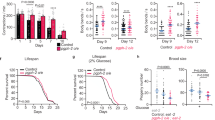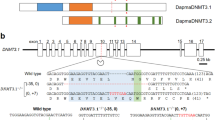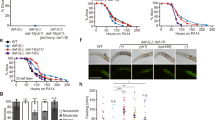Abstract
Many organisms can enter a dormant state or diapause to survive harsh environmental conditions for extended durations. When Caenorhabditis elegans larvae enter dauer they arrest feeding but remain active and motile, yet become stress-resistant, extremely long-lived and non-ageing1. Entry into dauer is associated with a reduction in insulin-like signalling, the accumulation of nutritive resources and a concomitant global change in metabolism2,3,4,5, yet the precise molecular and physiological processes that enable long-term survival in the absence of caloric intake remain largely unknown. We show here that C. elegans larvae that lack LKB1/AMPK (AMP-activated protein kinase) signalling enter dauer normally, but then rapidly consume their stored energy and prematurely expire following vital organ failure. We found that this signalling pathway acts in adipose-like tissues to downregulate triglyceride hydrolysis so that these lipid reserves are rationed to last the entire duration of the arrest. Indeed, the downregulation of adipose triglyceride lipase (ATGL-1) activity suppresses both the rapid depletion of stored lipids and reduced life span of AMPK mutant dauers, while AMPK directly phosphorylates ATGL-1. Finally, we show that the slow release of energy during dauer is critical for appropriate long-term osmoregulation, which fails as triglyceride resources become depleted. These mechanisms may be essential for survival through diapause, hibernation, or long-term fasting in diverse organisms and may also underlie AMPK-dependent life span extension.
This is a preview of subscription content, access via your institution
Access options
Subscribe to this journal
Receive 51 print issues and online access
$199.00 per year
only $3.90 per issue
Buy this article
- Purchase on Springer Link
- Instant access to full article PDF
Prices may be subject to local taxes which are calculated during checkout



Similar content being viewed by others
References
Klass, M. & Hirsh, D. Non-ageing developmental variant of Caenorhabditis elegans . Nature 260, 523–525 (1976)
Burnell, A. M., Houthoofd, K., O'Hanlon, K. & Vanfleteren, J. R. Alternate metabolism during the dauer stage of the nematode Caenorhabditis elegans . Exp. Gerontol. 40, 850–856 (2005)
Kimura, K. D., Tissenbaum, H. A., Liu, Y. & Ruvkun, G. daf-2, an insulin receptor-like gene that regulates longevity and diapause in Caenorhabditis elegans . Science 277, 942–946 (1997)
McElwee, J., Bubb, K. & Thomas, J. H. Transcriptional outputs of the Caenorhabditis elegans forkhead protein DAF-16. Aging Cell 2, 111–121 (2003)
McElwee, J. J., Schuster, E., Blanc, E., Thornton, J. & Gems, D. Diapause-associated metabolic traits reiterated in long-lived daf-2 mutants in the nematode Caenorhabditis elegans . Mech. Ageing Dev. 127, 458–472 (2006)
Kenyon, C., Chang, J., Gensch, E., Rudner, A. & Tabtiang, R. A. C. elegans mutant that lives twice as long as wild type. Nature 366, 461–464 (1993)
Narbonne, P. & Roy, R. Inhibition of germline proliferation during C. elegans dauer development requires PTEN, LKB1 and AMPK signalling. Development 133, 611–619 (2006)
Hardie, D. G. AMP-activated/SNF1 protein kinases: Conserved guardians of cellular energy. Nature Rev. Mol. Cell Biol. 8, 774–785 (2007)
Apfeld, J., O'Connor, G., McDonagh, T., DiStefano, P. S. & Curtis, R. The AMP-activated protein kinase AAK-2 links energy levels and insulin-like signals to lifespan in C. elegans . Genes Dev. 18, 3004–3009 (2004)
Fukushige, T., Hendzel, M. J., Bazett-Jones, D. P. & McGhee, J. D. Direct visualization of the elt-2 gut-specific GATA factor binding to a target promoter inside the living Caenorhabditis elegans embryo. Proc. Natl Acad. Sci. USA 96, 11883–11888 (1999)
Maduro, M. & Pilgrim, D. Identification and cloning of unc-119, a gene expressed in the Caenorhabditis elegans nervous system. Genetics 141, 977–988 (1995)
Masse, I., Molin, L., Billaud, M. & Solari, F. Lifespan and dauer regulation by tissue-specific activities of Caenorhabditis elegans DAF-18. Dev. Biol. 286, 91–101 (2005)
Okkema, P. G., Harrison, S. W., Plunger, V., Aryana, A. & Fire, A. Sequence requirements for myosin gene expression and regulation in Caenorhabditis elegans . Genetics 135, 385–404 (1993)
Myers, T. R. & Greenwald, I. lin-35 Rb acts in the major hypodermis to oppose ras-mediated vulval induction in C. elegans . Dev. Cell 8, 117–123 (2005)
McKay, S. J. et al. Gene expression profiling of cells, tissues, and developmental stages of the nematode C. elegans . Cold Spring Harb. Symp. Quant. Biol. 68, 159–169 (2003)
Sherman, T. et al. The abts and sulp families of anion transporters from Caenorhabditis elegans . Am. J. Physiol. Cell Physiol. 289, C341–C351 (2005)
Loria, P. M., Hodgkin, J. & Hobert, O. A conserved postsynaptic transmembrane protein affecting neuromuscular signaling in Caenorhabditis elegans . J. Neurosci. 24, 2191–2201 (2004)
Huang, P. & Stern, M. J. FGF signaling functions in the hypodermis to regulate fluid balance in C. elegans . Development 131, 2595–2604 (2004)
Mello, C. C., Kramer, J. M., Stinchcomb, D. & Ambros, V. Efficient gene transfer in C. elegans: Extrachromosomal maintenance and integration of transforming sequences. EMBO J. 10, 3959–3970 (1991)
Ogg, S. & Ruvkun, G. The C. elegans PTEN homolog, DAF-18, acts in the insulin receptor-like metabolic signaling pathway. Mol. Cell 2, 887–893 (1998)
Schweiger, M. et al. Adipose triglyceride lipase and hormone-sensitive lipase are the major enzymes in adipose tissue triacylglycerol catabolism. J. Biol. Chem. 281, 40236–40241 (2006)
Zimmermann, R. et al. Fat mobilization in adipose tissue is promoted by adipose triglyceride lipase. Science 306, 1383–1386 (2004)
Gronke, S. et al. Brummer lipase is an evolutionary conserved fat storage regulator in Drosophila . Cell Metab. 1, 323–330 (2005)
Gwinn, D. M. et al. AMPK phosphorylation of raptor mediates a metabolic checkpoint. Mol. Cell 30, 214–226 (2008)
Nelson, F. K. & Riddle, D. L. Functional study of the Caenorhabditis elegans secretory-excretory system using laser microsurgery. J. Exp. Zool. 231, 45–56 (1984)
Lamitina, S. T. & Strange, K. Transcriptional targets of DAF-16 insulin signaling pathway protect C. elegans from extreme hypertonic stress. Am. J. Physiol. Cell Physiol. 288, C467–C474 (2005)
Curtis, R., O'Connor, G. & DiStefano, P. S. Aging networks in Caenorhabditis elegans: AMP-activated protein kinase (aak-2) links multiple aging and metabolism pathways. Aging Cell 5, 119–126 (2006)
Greer, E. L. et al. An AMPK-FOXO pathway mediates longevity induced by a novel method of dietary restriction in C. elegans . Curr. Biol. 17, 1646–1656 (2007)
Schulz, T. J. et al. Glucose restriction extends Caenorhabditis elegans life span by inducing mitochondrial respiration and increasing oxidative stress. Cell Metab. 6, 280–293 (2007)
Feng, J., Bussiere, F. & Hekimi, S. Mitochondrial electron transport is a key determinant of life span in Caenorhabditis elegans . Dev. Cell 1, 633–644 (2001)
Acknowledgements
We thank A. Fire, O. Hobert, I. Greenwald, D. Baillie, K. Nehrke, J. McGhee, M. Han, S. Li, E. Colella, M. Hebeisen, J. Ouellet, A. Shingina, M. Maduro, F. Solari, E. Greer, J. Lapointe, W. Yang and S. Hekimi for reagents, strains, constructs, help, advice and support. Some of the strains that were used in this analysis came from the Caenorhabditis Genetic Center (CGC), the C. elegans Gene Knockout Consortium, the Japan National Bioresource Project, and the Genome BC C. elegans Gene Expression Consortium. This work was supported by research grants from the Canadian Cancer Society and the Canadian Institutes of Health Research (CIHR) to R.R. P.N. is a recipient of an NSERC studentship. R.R. is a CIHR New Investigator.
Author Contributions P.N. designed and conducted all the experiments, except the kinase assays, which were performed by R.R.. The manuscript was written by P.N. and edited by R.R.
Author information
Authors and Affiliations
Corresponding author
Supplementary information
Supplementary Information
This file consists of Supplementary Notes, Supplementary Table 1, and Supplementary Figures 1-2 with Legends. (PDF 10327 kb)
Rights and permissions
About this article
Cite this article
Narbonne, P., Roy, R. Caenorhabditis elegans dauers need LKB1/AMPK to ration lipid reserves and ensure long-term survival. Nature 457, 210–214 (2009). https://doi.org/10.1038/nature07536
Received:
Accepted:
Published:
Issue Date:
DOI: https://doi.org/10.1038/nature07536
This article is cited by
-
A transcriptomic examination of encased rotifer embryos reveals the developmental trajectory leading to long-term dormancy; are they “animal seeds”?
BMC Genomics (2024)
-
A new AMPK isoform mediates glucose-restriction induced longevity non-cell autonomously by promoting membrane fluidity
Nature Communications (2023)
-
Glycerol 3-phosphate phosphatase/PGPH-2 counters metabolic stress and promotes healthy aging via a glycogen sensing-AMPK-HLH-30-autophagy axis in C. elegans
Nature Communications (2023)
-
The unfolded protein response reverses the effects of glucose on lifespan in chemically-sterilized C. elegans
Nature Communications (2022)
-
Endocrine function of pheromones couples fat rationing and nutrient scarcity
Science China Life Sciences (2022)
Comments
By submitting a comment you agree to abide by our Terms and Community Guidelines. If you find something abusive or that does not comply with our terms or guidelines please flag it as inappropriate.



